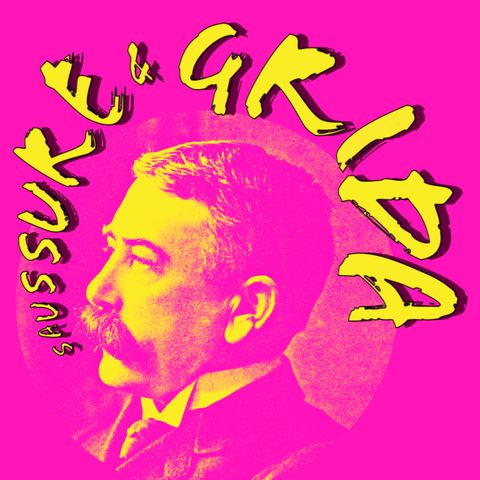16. Aiuto, lingue in pericolo! Come avviene l'estinzione linguistica e come provare ad evitarla

Download and listen anywhere
Download your favorite episodes and enjoy them, wherever you are! Sign up or log in now to access offline listening.
Description
In questo episodio esploriamo il processo complesso e multifattoriale della scomparsa di una lingua, che avviene sempre in un contesto di contatto linguistico, osservando le cause principali che nella storia...
show moreCercheremo insieme anche di capire come possiamo preservare la diversità linguistica, sottolineando come l'inclusività e la cooperazione tra comunità linguistiche siano essenziali per mantenere vive le lingue minacciate e promuovere una maggiore apertura culturale.
Grafiche: Gianluca La Bruna
La sigla è stata prodotta da White Hot e fornita da https://freebeats.io
Link per finanziamento LingComm: https://lingcomm.org/grants/
FONTI:
- Beisaw, A.M. (2012). Environmental History of the Susquehanna Valley Around the Time of European Contact. Pennsylvania History: A Journal of Mid-Atlantic Studies 79(4):366-376.
- Berruto G. (2016). Sulla vitalità delle linguae minores. Indicatori e parametri. In A. Pons (Ed.) Vitalità,morte e miracoli dell’occitano. Atti del Convegno del 26 settembre 2015 (:11-26). Pomaretto: Associazione Amici della Scuola Latina.
- Canvin, M., & Tucker, I. (2019). Mapping Linguistic Vitality and Language Endangerment. In S. Brunn, & R. Kehrein (Eds.) Handbook of the Changing World Language Map. Edinburgh: Springer, Cham.
- Contri, P. (2017). Lingue invisibili. La protezione delle lingue regionali in Italia e la questione della lingua veneta. MA Thesis. Lingue invisibili. Dipartimento di lingue moderne per la comunicazione e la cooperazione internazionale, University of Padua.
- Ethnologue: https://www.ethnologue.com/
- Fornaciari, P.E. (1983). Aspetti dell'uso del «Bagitto» da parte dei Gentili. La Rassegna Mensile di Israel, terza serie, La Cultura Sefardita, 49(5/8):432-454.
- Jennings, F. (1968). Glory, Death, and Transfiguration: The Susquehannock Indians in the Seventeenth Century. Proceedings of the American Philosophical Society, 112(1):15–53.
- Laakso, J. (2014). Dangers and Developments: On Language Diversity in a Changing World. Studies in European Language Diversity, 34 (:9-23). Mainz: ELDIA.
- Lee, N. H. 2020. The Status of Endangered Contact Languages of the World. Annual Review of Linguistics, 6:301–18.
- Lewis, M.P, & Simons, G.F. (2010). Assessing endangerment: Expanding Fishman's GIDS. Revue roumaine de linguistique. 55(2):103–120.
- Moseley, C. (2010). UNESCO Atlas of the World's Languages in Danger. Paris: UNESCO.
- Niemi, M. (2002). Traduzione di Katia De Marco. Musica rock da Vittula. Iperborea.
- Patria, R., & Merdeka, P.H. (2023). Creative Strategies in the Recovery of Endangered Languages. Journal of Literature Language and Academic Studies, 2(02):57–61.
- Pedley M., & Viaut A. (2019). What do minority languages mean? European perspectives. Multilingua, 38(2):133-139.
- Pischlöger, C. (2016). Udmurt on Social Network Sites: A Comparison with the Welsh Case. In R. Toivanen & J. Saarikivi (Ed.), Linguistic Genocide or Superdiversity?: New and Old Language Diversities (:108-132). Bristol, Blue Ridge Summit: Multilingual Matters.
- Ridanpää, J. (2018). Why save a minority language? Meänkieli and rationales of language revitalization. Fennia - International Journal of Geography, 196(2):187–203.
- Rigo, A.C. (2021). Minority and Endangered Languages in the World - International, European and National Policies to Counteract Language Death. MA Thesis. Dipartimento di Studi Linguistici e Culturali Comparati, Ca' Foscari University of Venice.
- Roche, G. (2020). Abandoning endangered languages: ethical loneliness, language oppression, and social justice. American Anthropologist, 122(1):164-169.
- Salminen, T. (2008). Chapter 10. Endangered Languages in Europe. In M. Brenzinger (Ed.), Language Diversity Endangered (:205-232). Berlin, Boston: De Gruyter Mouton.
- Thomason, S. G. (2015). Endangered Languages: An Introduction. Cambridge: Cambridge University Press.
- Wesley, Y.L. (2023). Refusing “Endangered Languages” Narratives. Daedalus, 152(3):69–83.
Information
| Author | Irene |
| Organization | Irene Lami |
| Website | - |
| Tags |
Copyright 2024 - Spreaker Inc. an iHeartMedia Company
